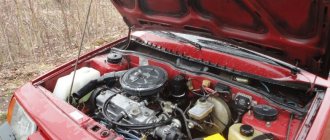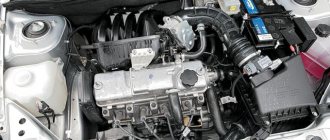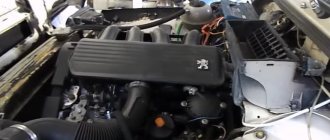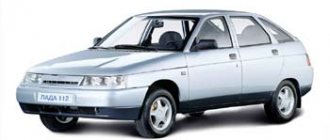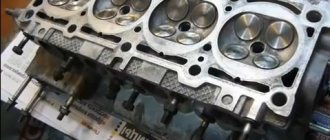The popular VAZ 2108 model was equipped with time-tested four-cylinder gasoline engines with an overhead camshaft. These engines, depending on their specific modification, had a displacement of 1.1 liters, 1.3 and 1.5 liters. The most widespread was the 1.3 liter VAZ 2108 engine, which was economical and provided the car with good dynamics. We will tell you about the features of this engine, as well as what kind of engine can be installed in a VAZ.
Specifications
Characteristics of the 1.3 liter VAZ 2108 engine:
| PARAMETER | MEANING |
| Years of manufacture | 1984 – 2004 |
| Weight | 127 kg |
| Cylinder block material | cast iron |
| Supply system | carburetor |
| Type | in-line |
| Working volume | 1.3 |
| Power | 64 horsepower at 5600 rpm |
| Number of cylinders | 4 |
| Number of valves | 2 |
| Piston stroke | 71 |
| Cylinder diameter | 76 |
| Compression ratio | 9.9 |
| Torque, Nm/rpm | 95 Nm / 3400 |
| Environmental standards | EURO 2 |
| Fuel | AI 93 |
| Fuel consumption | 8.2 l/100 km combined cycle |
| Oil | 5W-30 – 15W40 |
| Oil volume | 3.5 liters |
| When replacing, pour | 3.2 liters |
| Oil change is carried out | 15 thousand km |
| Engine life - according to factory data - in practice | 120+ 200+ |
This motor is installed on:
- VAZ 2108;
- VAZ 21099;
- VAZ 2109.
Tuning carburetor engine VAZ 2108 1.3 l.
Modification of this unit is not as common as tuning 21083 1.5 due to the lack of meaning; all other things being equal, the 083 engine will always be ahead, it initially has greater volume, power, torque and huge potential for modifications at the same or lower costs. Occasionally, boring for a 79 mm piston is practiced, resulting in a volume of 1.4 liters, but the walls will be very thin, overheating is possible, and accordingly the service life is sharply reduced. The simplest and most inexpensive tuning of a 2108 1.3 engine is to buy a 21083 1.5 l engine or block 083 and finish it to the desired level.
Boring the VAZ 2108 engine and how to boost it correctly
The option of obtaining a volume of 1.4 liters is practiced. installation of Kalinovsky pistons 76.5 and Kalinovsky crankshaft 75.6, connecting rods from the same with shrinkage of 2.3 mm. Cylinder head from 083 or 16 valves from Kalina. On the shafts, intake and exhaust the car will go faster than the new Priora.
Injector for VAZ 2108 engine
On a car with a 1.3 engine, you can install an injector from a 1.5 liter 21083, everything will work on standard firmware.
Rotary engine VAZ 2108
Building a good sports engine for a VAZ 2108 1.3 is a complex and resource-intensive thing; installing a powerful rotary engine right away is another matter. The eight can be equipped with an RPD-415 engine with a power of 140 hp. Disadvantages of a rotary engine: price (about $3000), short service life (even lower during active driving), fuel and oil consumption is much higher than a standard internal combustion engine. Advantages of RPD: high dynamic performance, acceleration to 100 in less than 9 seconds, speed of more than 180 km/h.
ENGINE RATING: 3
<<BACK
Peculiarities
A 1.3-liter gasoline power unit appeared in the production line of the Volzhsky Automobile Plant in 1984. This motor used a number of technological innovations and was partially controlled electronically. This made it possible to improve engine power and also had a positive effect on fuel efficiency.
The VAZ engine power is 64 horsepower and the torque is 95 Nm. Unlike its predecessors, this power unit was originally designed to use 93 octane fuel.
Pros and cons
Taking into account the characteristics of the engine, in particular the small volume of 1.3 liters, immediately after launch into production the following shortcomings were revealed:
- leaks through the block cover gasket - the error has not been corrected;
- Solex carburetor - required frequent adjustment of the idle modes;
- pump - intensive wear of polymer blades.
Carburetor for 2108
Since the 2108 engine was the first with a transverse arrangement under the hood of a car, the default exhaust manifold changed its design in comparison with previous generations of AvtoVAZ internal combustion engines. However, the intake manifold remained the same.
Modifications
In its initial modifications, this unit had a carburetor power system and only in the late 90s it received a modern injector. The latter made it possible to provide the car with improved dynamics, and maximum traction was achieved at low revs.
The use of the injector also had a positive effect on fuel consumption, which on average began to consume less than 7 liters on the highway.
Among the advantages of this modification of the power unit, we can note the simplicity of the VAZ 2108 engine, which had a positive effect on its reliability and maintainability. This especially applies to carburetor modifications, the repair of which could be carried out by the car owner himself.
Unlike the 1.5 liter VAZ engines, this engine had a belt drive, which forced car owners to carry out service work every 50 thousand kilometers. With proper and careful operation, the service life of this engine reaches 200,000 kilometers.
The small engine turned out to be quite compact, and the use of aluminum for the cylinder head made it possible to reduce its weight. At the same time, the cylinder block itself is cast from cast iron, which improves the temperature stability of the engine.
Despite its small volume, this engine endowed the eighth VAZ model with excellent dynamics. The car's cruising speed was 120 kilometers per hour, and the engine itself worked primarily in tandem with a five-speed gearbox. This transmission became a novelty on VAZ cars and was very popular among buyers.
Block head and timing device
All front-wheel drive cars of the VAZ family, be it 2109, 2110 or 2114, have one cylinder head, common to all cylinders. They are mounted to the block using ten screws. During installation, a metal gasket is placed under it. This gasket is for single use and cannot be reused. There are five camshaft bearings at the top of the cylinder head.
The camshaft of the engine of the VAZ-2109 car has the index 21083. Some engines are equipped with 2110 or 2111 shafts; their design is slightly different from 21083, which allows for an increase in engine power. The shaft is cast from cast iron, there are five supports and eight cams on it that open the valves. It is driven by a toothed belt from the crankshaft pulley. The shafts can be correctly installed relative to each other using the alignment lug on the rear timing belt cover and the marks on the drive gears and flywheel.
Seats are pressed into the cylinder head, as well as valve guides. On the inside of the bushings there are grooves for supplying lubricant; the bushings are closed on top with oil deflector caps.
The valves are made of steel, and the intake head is made of heat-resistant steel. They are mounted obliquely in one row. The inlet valve has a larger diameter than the outlet valve. The gaps between the valves and camshaft cams are adjusted using shims that have increased wear resistance.
Flaws
Like any other model of power units from Tolyatti, the VAZ 2108 engines were not without shortcomings.
- For example, car owners quite often encounter wear and tear on the cooling system. The pump and thermostat could break down with regularity every 20,000 kilometers.
- It is also necessary to note the absence of hydraulic compensators, so the valve adjustment procedure was carried out every 10,000 kilometers.
- It should also be noted the mediocre reliability of Solex carburetors. Subsequently, carburetors of this type were replaced with a new, more reliable modification. With age, ignition problems could arise.
- It should be noted that this power unit has increased requirements for the quality of the oil and gasoline used. While most other VAZ modifications of power units could easily run on low-octane gasoline, this engine quickly failed when using 76 gasoline. The same applies to the quality of the oil. It was recommended to replace it every 15 thousand kilometers.
Maintenance and repair
The motor was designed by domestic engineers, so the owner with basic equipment maintenance skills can disassemble and reassemble the unit. Repair of the VAZ 2108 engine takes place in garages, or, in extreme cases, at inexpensive universal services.
It makes no sense to consider individual components; it would be more correct to describe a typical overhaul. The dimensions and weight of the VAZ 2108 engine allow it to be removed from the engine compartment with a conventional winch.
- The piston group is at least thoroughly cleaned of carbon deposits. Then the dimensions of the annular grooves and gaps between the rings are measured. If the value exceeds the factory settings, a boring for the repair kit is required. Cylinder liners also increase in size. The engine volume changes slightly.
- Connecting rods are sorted by backlash. It's a good idea to have used kits for this motor model in stock. In general, when replacing parts, do not throw away the old ones. In a critical situation (with the search for spare parts), you can use your NZ. The check is carried out by the presence of gaps and the characteristic rocking of the connecting rods on the fingers.
- The crankshaft is checked most carefully. It's better to use a magnifying glass. In addition to inspecting for damage, be sure to measure the diameters with a micrometer. If the size is outside the range, the part must be replaced. The same goes for liners and half rings. Any scratch or nick will not be sanded.
Important! If there are burrs in the crankshaft group, check the oil channels. The reason for increased wear is oil starvation.
- The cylinder block is checked for cracks and deformation of the adjacent surface. If necessary, grinding is carried out. It wouldn't hurt to clean the cooling jacket channels; this engine model has problems with antifreeze circulation. The volume of the channels decreases due to plaque on the walls, and the cooling efficiency decreases.
- Wash the crankcase block well in kerosene. It wouldn't hurt to check the oil seal seats - the engine can leak not only because of worn rubber. The volume of oil “for waste” reaches 1 liter.
- The flywheel is checked for crown chips. The unit is reliable, there is basically nothing to break. Check the seat on the crankshaft.
- Attachment reliability varies by model. Has nothing to do with engine repair. Although, a jammed water pump can break the timing belt with all the consequences...
If there is no need to gain access to the crankshaft, the rest of the repairs can be done directly in the car. The engine model and the volume of the engine compartment allow.
Malfunctions
| FAULTS | CAUSES AND REPAIRS |
| The engine does not start well and a characteristic shudder appears. | This engine has ignition problems, and if there are problems with the engine's operation, the ignition must be installed correctly. |
| Oil leaks appear after the car is parked. | The weak point of this engine is the valve cover seal. In this case, the repair consists of replacing the gasket. |
| The appearance of pronounced detonation. | If such detonation occurs when using high-quality gasoline, it is necessary to replace the fuel filter. |
| While driving, a sharp knocking sound appeared, after which the engine would not start. | This is typical for a broken timing belt. The design of the VAZ 2108 engine is such that if the timing belt breaks, the valves bend. Repair in this case consists of replacing valves and other damaged elements. |
Lubricating parts
Combined engine lubrication device for the VAZ-2109 (2110). Oil is supplied to the main and connecting rod bearings, as well as to the camshaft supports under pressure; the cylinders, pistons, pins and rings, camshaft cams and pushers are lubricated by splashing; all other associated parts are lubricated by gravity.
A gear-type oil pump with a bypass valve is installed at the front of the block. The oil receiver is mounted using bolts on the cover of the second main bearing and the pump housing. The oil filter is non-separable and has bypass and anti-drainage valves. The design of the lubrication system and other engine systems is discussed in detail in separate articles. » alt=»»> Crankcase ventilation is forced, gases are removed through the oil separator.
Tuning
Due to the small displacement, increasing the power of the VAZ 2108 engine is a certain difficulty.
- Many car owners of the version with a carburetor installed an injector, which allowed them to get about 10 horsepower.
This engine does not involve boring the cylinders and installing additional reinforced elements. We also do not recommend that you try to increase the power of this engine by installing a turbine. Such tuning of the VAZ 2108 engine invariably reduces the life of the power unit, so such a turbocharged engine may need major repairs after 50-70 thousand kilometers.
- If you do not have enough power, it is possible to install a modified 1.5 liter engine in the engine compartment. Such an engine swap will allow you to get a VAZ engine power of around 100 horsepower. An experienced motor mechanic will tell you which engine can be installed in a VAZ.
Description
VAZ engineers, together with specialists from the Porsche concern, have designed a power unit intended for installation in a front-wheel drive car with a 5-speed gearbox. The engine was created and first introduced on the famous V8 or Lada Sputnik in 1984.
The engine was named after the car - VAZ-2108 and became the base for the new, eighth series of AvtoVAZ power units. Engine production continued until 2004. Periodic improvements gave rise to new modifications of the internal combustion engine. Additionally, variants of experimental models of 1.5 liters and 1.6 liters with 16-valve timing were developed.
A modification of the deformed 1.1 liter unit was produced for a short time and was not widely used. The 1.5 liter engine was produced in two versions - carburetor and injection.
The VAZ-2108 is a four-cylinder naturally aspirated petrol engine with a volume of 1.3 liters and a power of 63 hp. s and torque 94 Nm.
Under the hood – VAZ-2108
Installed on VAZ cars:
- 2108 (1984-2004);
- 2109 (1987-1997);
- 21099 (1990-2004).
VAZ-2108 is highly compact. This parameter is due to several innovative technical solutions.
- Firstly, by reducing the center-to-center distances of the cylinders to 89 mm (for the classic it is 95 mm).
- Secondly, the dimensions of the connecting rod length were changed from 136 to 121 mm, the height of the cylinder block, the length of the valves from 111 to 102 mm, and the height of the cylinder head. The crankshaft and camshaft have become shorter.
- Thirdly, the design of the oil pump drive has been changed. Its rotation occurs without intermediate parts, directly from the crankshaft.
- Fourthly, the cooling water pump is built into the cylinder block. In addition, a number of engine elements have been reduced.
The improvement in engine efficiency was facilitated by an improved combustion chamber with a compression ratio increased to 9.9 units. Changes in the fuel supply and ignition systems are also important.
Ensuring high completeness of combustion of the working mixture ensures compliance with strict environmental requirements, resulting in less toxic exhaust.
Additionally, it was possible to significantly reduce the noise of the unit. This was mainly achieved due to increased crankshaft balance, reduced vibration of the internal combustion engine as a whole and high-quality manufacturing of engine components. For example, the gaps in the ShPG and valves have been significantly reduced.
The cylinder block remained traditionally cast iron, not lined. The surface to which the block head is attached is made more rigid.
The cylinder head is cast from aluminum alloy, reinforced with stiffeners. The head structure is shown in the figure from the VAZ-2108 engine repair manual.
Cylinder head VAZ-2108
The cylinder head gasket has been fundamentally changed. Firstly, it is made of non-shrink material. Secondly, the oil channels are additionally sealed.
The pistons are aluminum, with three rings, two of which are compression, one is oil scraper. Made of cast iron, the working surface is covered with chrome. Additionally, the piston has a thermo-fixing ring.
The crankshaft is cast iron, with graphite included. Internal balance is 62% (on classic engines - 40%).
The valve mechanism is also structurally simplified. Adjustment of the thermal gap remains the same, manual. Since hydraulic compensators are not provided in the design, the gap is adjusted with washers.
During operation, the valve rotates around its axis, which ensures more uniform wear. Unfortunately, the old problem - bending of valves when the timing belt breaks - remains.
The timing belt drive is common to the camshaft and pump. The generator rotates with its belt from the crankshaft, and the ignition distributor and fuel pump rotate directly from the camshaft.
The cooling system is designed according to the traditional design - closed type with forced circulation of coolant.
The lubrication system is also traditional, with structural changes to the system elements and their installation locations on the unit. By the way, the manufacturer notes that the VAZ-2108 is absolutely not demanding on the quality of engine oil.
In the power supply system, changes include the presence of a fuel return line and a thermostat to maintain a given air temperature at the carburetor inlet. The rest of the design solutions are not critical; they are mainly related to changes in their location.
The use of advanced technologies from the German automobile industry in the design made it possible to create an engine that has won recognition from a wide range of car enthusiasts.
Cleaning the G8 carburetor without disassembling it
If the engine of your “swallow” begins to stall, “eats” a lot of gasoline, or you feel jerks and dips when driving and starting the engine, it makes sense to clean the carburetor, since it is usually its contamination that causes all these troubles. Cleaning according to all the rules involves dismantling the carburetor and disassembling it, which, of course, is not suitable for all car enthusiasts. For “lazy” drivers, another, faster and quite effective cleaning method was invented, which involves the use of a special aerosol.
Such aerosols from different manufacturers (Kleen-Flo, MANNOL, ABRO, etc.) contain special compounds that do an excellent job of removing contaminants in the carburetor. They are very easy to use, all you need to do is:
- remove the air filter cover;
- unscrew the plug holder on the carburetor or the solenoid valve;
- using a nozzle tube, spray the nozzle channels, both chambers, the throttle and air valves and all other mechanisms;
- Spray liquid from a can onto the outer parts of the carburetor.
After applying the composition, it is advisable to rest for a few minutes. During this time, the cleaner will be able to soften and effectively corrode all contaminants. Then you should start the VAZ 2108 engine, pull the “choke” lever towards you and apply the cleaner into the air channels and chambers of the carburetor. A similar operation can be performed a couple of times. After such a simple cleaning, you will see for yourself how much more “vigorous” your “eight” has become.
What to do with increased consumption
Before you tightly grasp the carburetor, be sure to make sure that the other systems are in good working order - the spark plugs are in working order, the high-voltage wires do not break through to ground, and there is compression in the engine cylinders (the minimum value for the VAZ 2108 is 11 Bar). Unscrew the spark plugs and check the condition of the electrodes.
Important. The color of the electrodes reflects the picture of the operation of the power unit. A black coating indicates that the mixture is over-rich, the proportion of gasoline in it is too high. White color indicates a lean mixture, the norm is a light brown tint.
Light brown is the correct color for the electrodes on the spark plugs
The most unpleasant problem is an increase in fuel consumption, which occurs for the following reasons:
- the economizer diaphragm is worn out;
- the main air jet or channels inside the unit are clogged;
- the needle valve, which limits the flow of fuel into the float chamber, does not hold;
- jets of unknown origin from a repair kit were installed.
Location of the economizer cover
Note. Listed here are problems that you can solve on your own. If the recommended measures do not have an effect, then the malfunction is more complex and you will have to contact a carburetor repair specialist to fix it.
To check the diaphragm, remove the air filter housing (the cover is secured with 3 10 mm nuts, the housing with 4 8 mm nuts). On the left wall of the carburetor in the direction of travel of the car, find a triangular economizer cap screwed with 3 screws, unscrew them with a Phillips screwdriver. Underneath there is a spring-loaded membrane that needs to be checked and replaced if necessary.
Removing the filter on the figure eight
You can read more about adjusting the carburetors of OKA cars here:
To eliminate other causes, you will have to remove the top cover of the Solex by disconnecting the starter cable and unscrewing the 5 fastening screws with a Phillips screwdriver. Then follow the instructions:
- Unscrew the air jets, remembering where each one should be. Fuel jets are hidden under them in the wells; unscrew them with a thin screwdriver and pull them out with a toothpick. Blow through the calibrated holes thoroughly.
- Using a blower, suck the gasoline out of the float chamber along with the dirt. Fill all channels and diffusers with the product from an aerosol can, wait for the time indicated on it and carefully blow out the carburetor without removing it from the car.
- Take the removed cover of the unit, turn it with the floats up and try to blow into the fuel supply pipe, plugging the pressure release fitting with your finger. If air passes through, replace the needle valve as it will also allow gasoline to pass through unhindered.
- If you replaced all the jets before increasing the flow rate, feel free to unscrew them and throw them away, and return the standard ones to their place.
- Before assembly, make sure that the floats do not touch the walls of the chamber; if necessary, carefully bend them.
- Reassemble the Solex in reverse order and begin adjusting.
To remove the top cover of the Solex you need to unscrew 5 screws
Reference. Oddly enough, with a lean mixture, gasoline consumption also increases. Since the car “does not pull” due to lack of fuel, you solve the problem by pressing the gas too hard, or even pulling the “choke”, half closing the air with the damper. Naturally, fuel is consumed beyond the norm.
Briefly about the key components of the G8 carburetor
The Solex 1107010 carburetor, which is installed on the Lada 2108, is an emulsion device with two chambers. It has a cable-actuated throttle body (manual). The lower chamber of the carburetor contains dampers and a float compartment. It also has a housing with special diffusers. The upper chamber has a cover covering the body and fuel fittings. This cover is equipped with studs (they secure the air filter) and a flange.
The Solex 1107010 design provides for a number of key components:
- accelerator pump;
- float device;
- throttle control system;
- forced idle economizer system;
- two chambers and their dosing mechanisms;
- starting device (manually controlled);
- econostat;
- idle system.
In addition, the carburetor has many other mechanisms and individual parts that ensure its stable operation.
